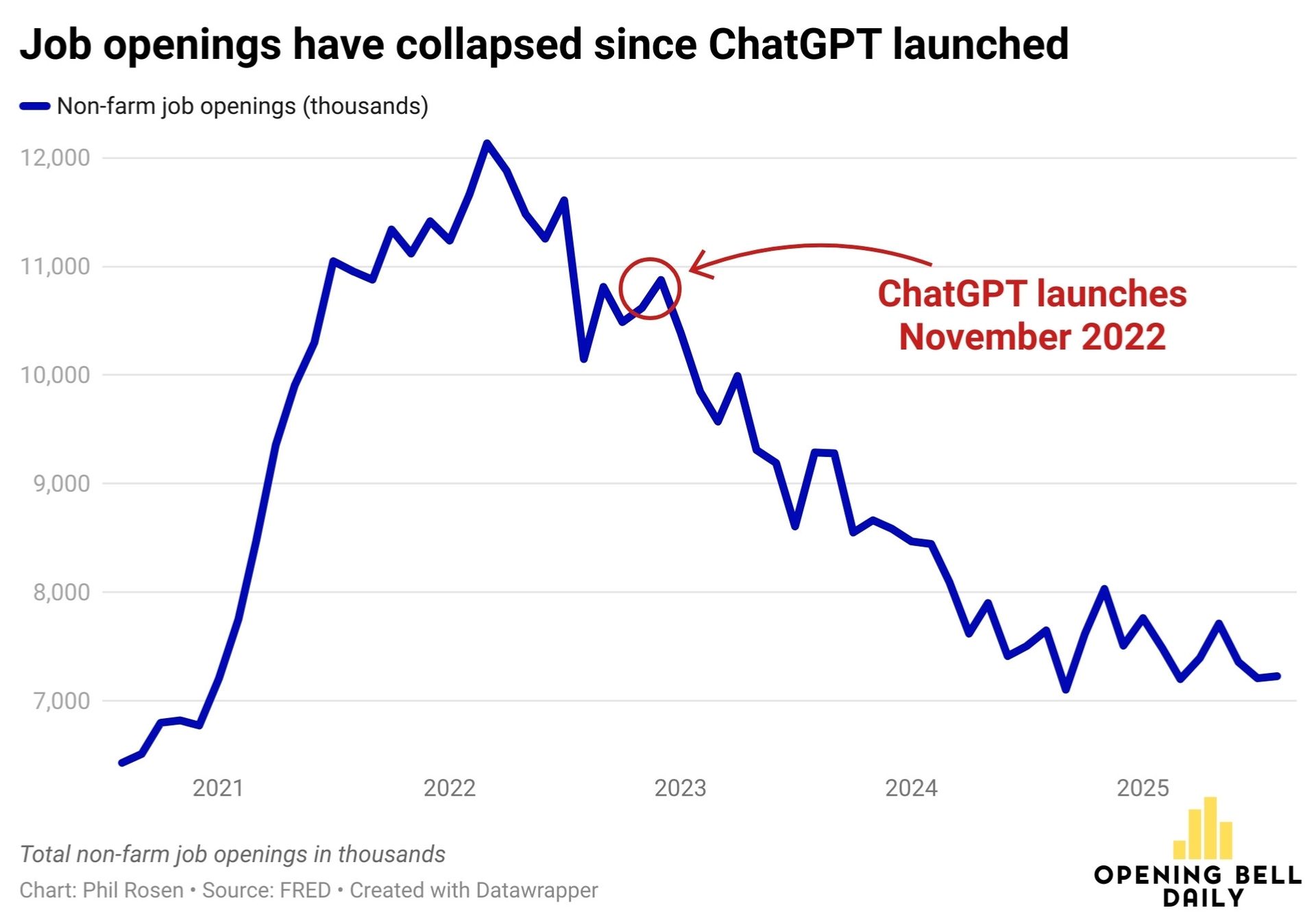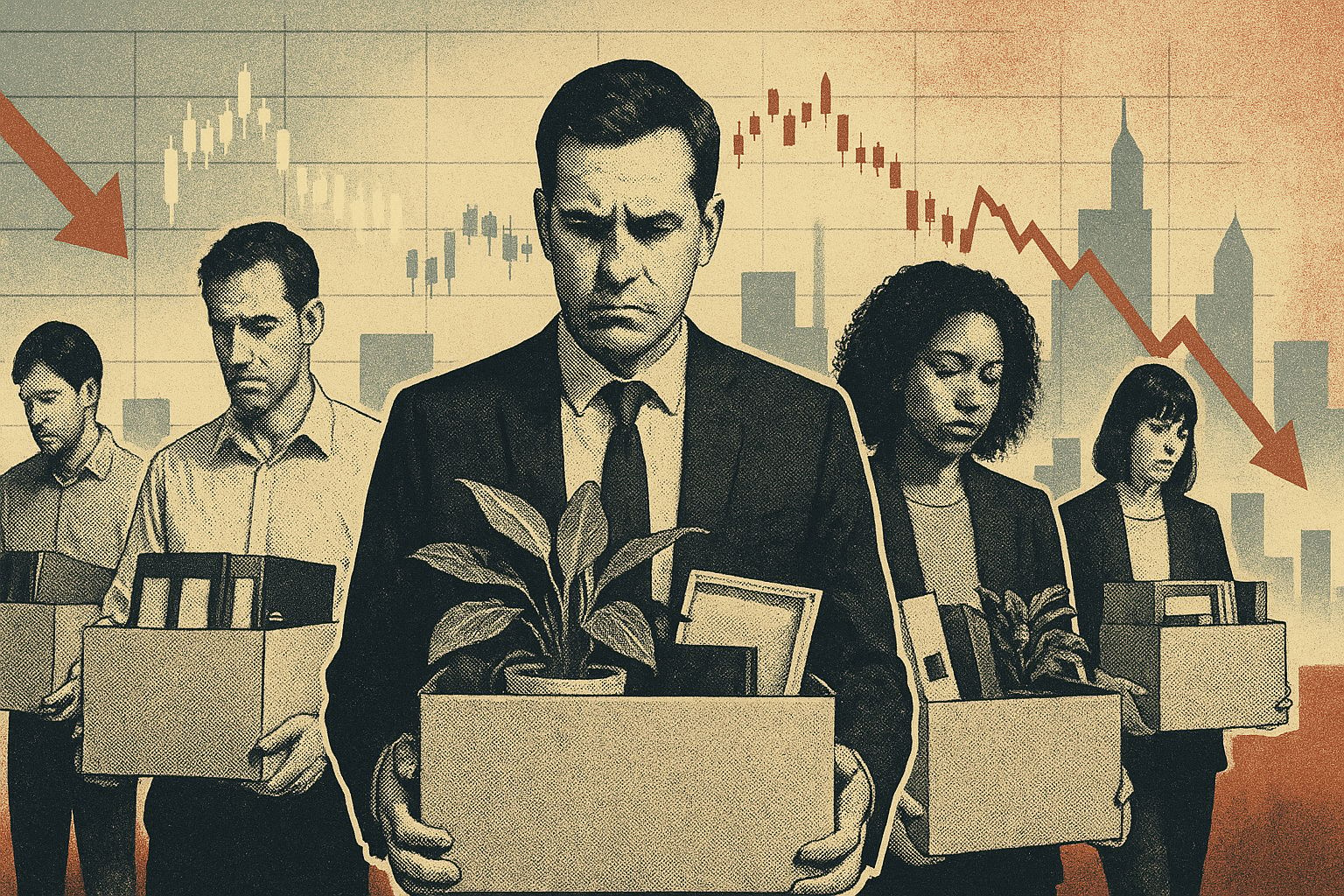Good morning! I’m excited to share that our team is launching a new show today. It’s called Full Signal.
Every week, I’ll share my take on markets using data you won’t find anywhere else, paired with Opening Bell’s signature charts and exclusive interviews.
If you’re reading this, you’re already an independent thinker and optimist — exactly who we’re making this show for.
Be sure to subscribe on YouTube and tune in to our first episode airing Wednesday.
3 charts behind job market shrinkage
Everyone recognizes that the job market is losing momentum but it’s hard to find consensus as to why.
The unemployment rate is creeping higher and job growth is stagnant
Companies like Amazon and Meta are initiating layoffs and blaming AI-driven productivity increases
Employees feel less confident about leaving their current roles
Unemployed Americans are taking longer to find new jobs
The reality is that there’s no single reason creating this cocktail of labor market headwinds.
Instead, there seem to be three forces colliding at once.
1. Pandemic hiring wasn’t built to last
The labor market has been what’s pushing the Federal Reserve to cut rates in 2025, but it’s been cracking ever since the COVID hiring surge started to lose steam.

The number of available job openings exploded to over 12 million at the peak of the boom in 2022, and employees had the upper hand against employers.
At the time, it was easy to job-hop. Companies struggled to retain talent.
But much of that hiring turned out to be temporary, a consequence of overstimulated demand and government stimulus checks.
Once spending patterns normalized, employers realized they had hired ahead of sustainable growth, explaining the recent pullback.
2. The Fed turned off the easy-money in March 2022
The same chart lines up with the Fed’s rate-hiking cycle that started in March 2022.

Rising interest rates forced companies to rethink expansion plans and slow down hiring plans.
Tighter monetary policy marked a turning point for the labor market that had been so employee-friendly.
While the central bank at the time adjusted rates to combat inflation, it also sparked the beginning of a steady, two-year decline in job openings.
3. AI and rising productivity
Versions of the chart below have made rounds on social media over the last week, but as the above two charts illustrate, AI is only one component of a three-legged stool.

It’s true that job openings have fallen off sharply since OpenAI released ChatGPT and kicked off the AI revolution, but that happened in concert with rising rates and a structural labor market retrenchment coming out of the pandemic.
That said, AI tools are nonetheless enabling businesses to increase their output with fewer people — opening the door as both an excuse for layoffs as well as legitimate justification.
What’s more, the new technology is reshaping hiring priorities even for companies that haven’t trimmed headcount.
Over time, it’s possible that meaningful productivity gains from AI work to lower the demand for labor even as economic growth accelerates.
Today’s letter is brought to you by Bitcoin IRA!

Smart investors use BitcoinIRA:
Tax Savings: When you trade in an IRA, you don't have to pay capital gains taxes that can be as high as 37%
Top-Level Security: Assets are custodied with a US based custodian and insured up to $250M²
World Class Customer Service: BitcoinIRA’s specialists will help guide you through every step of the process
P.S. As an Opening Bell Daily reader, you can earn up to $500 in rewards* when you add funds to your account.
Market snapshot

Elsewhere
📦 Amazon signed a deal with OpenAI. It’s a 7-year $38 billion agreement will allow the ChatGPT creator to access Nvidia chips housed within Amazon Web Services. Shares of Amazon climbed 4.6%. (Yahoo Finance)
🏦 Fed Governor Lisa Cook gave a new speech. In her first policy comments since her spat with President Trump, she said she remains undecided on a December move, and that she agreed with the previous rate cut. (CNBC)
📉 The ISM Survey remains weak. Pockets of strength in aerospace and AI couldn’t prevent an overall decline in the index from a month ago, with economic uncertainty still weighing on the manufacturing industry. (Barron’s)
🤖 Mindstream is how 200,000+ readers keep on top of AI. The daily newsletter delivers actionable insights and news you need to know to stay ahead of the curve and maximize AI in your life. The best part? It’s completely free. Get smarter on AI in minutes a day.
Rapid-fire
Palantir stock soared after beating earnings expectations but then erased its gains (Barron’s)
Ether dropped 9% Monday after a multi-million dollar hack hit the network (CNBC)
Bank of America reports earnings this week as it’s stock lags the other major banks this year (Bloomberg)
More consumers are slipping into the riskiest credit segment, underscoring the K-shape economy (Yahoo Finance)
Alphabet will sell $17.5 billion in bonds in the US (Bloomberg)
President Trump decided against discussing advanced Nvidia chip exports during his meeting with China’s Xi Jinping (WSJ)
Aluminium prices hit a three-year high (Bloomberg)
Berkshire Hathaway stock’s “Buffett Premium” is dwindling this year (Opening Bell Daily)
The AI mega-deals are here and stocks will keep marching higher (Pomp Letter)
On this day
🗓 November 4, 2016: The S&P 500 dropped for nine sessions in a row to mark its worst stretch in more than three decades, fueled by an elevated VIX and election-season jitters.
Last thing
📩 Want to get in front of 190,000+ investors who get this newsletter and the 350,000 professionals who can access it on Bloomberg Terminals? Reply to this email and tell us why we should work together.
About me
📰 I’m Phil Rosen, co-founder and editor-in-chief of Opening Bell Daily. I’ve published books, lived on three continents, and won awards for my journalism, which has appeared in Business Insider, Fortune, Yahoo Finance, Bloomberg and Inc. Magazine.
I write our flagship newsletter to prepare you for each trading day — unpacking markets, economic data and Wall Street with analysis you won’t find anywhere else.
Feedback? Reply to this email, ping me on X @philrosenn, or write me directly at [email protected].

